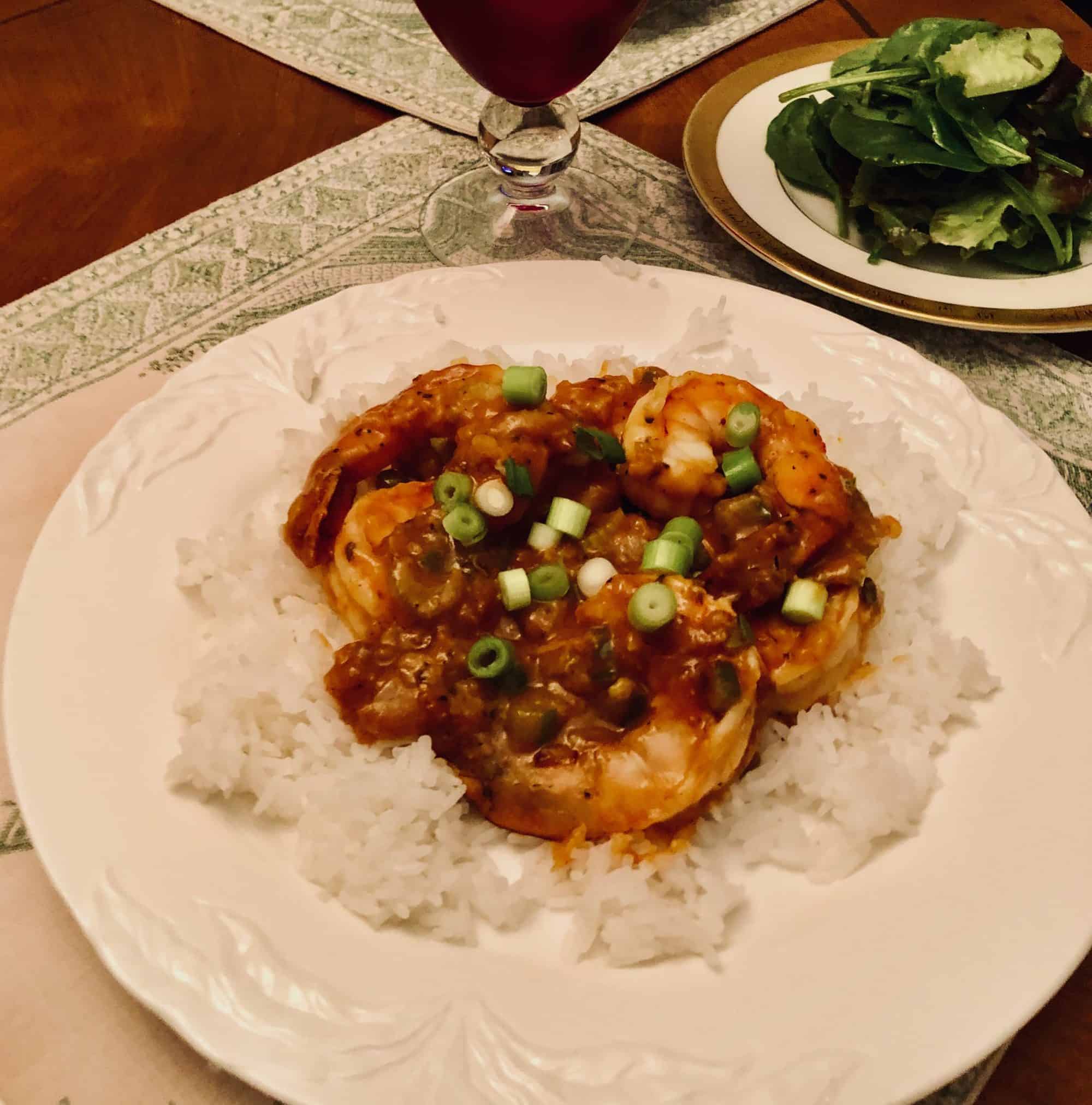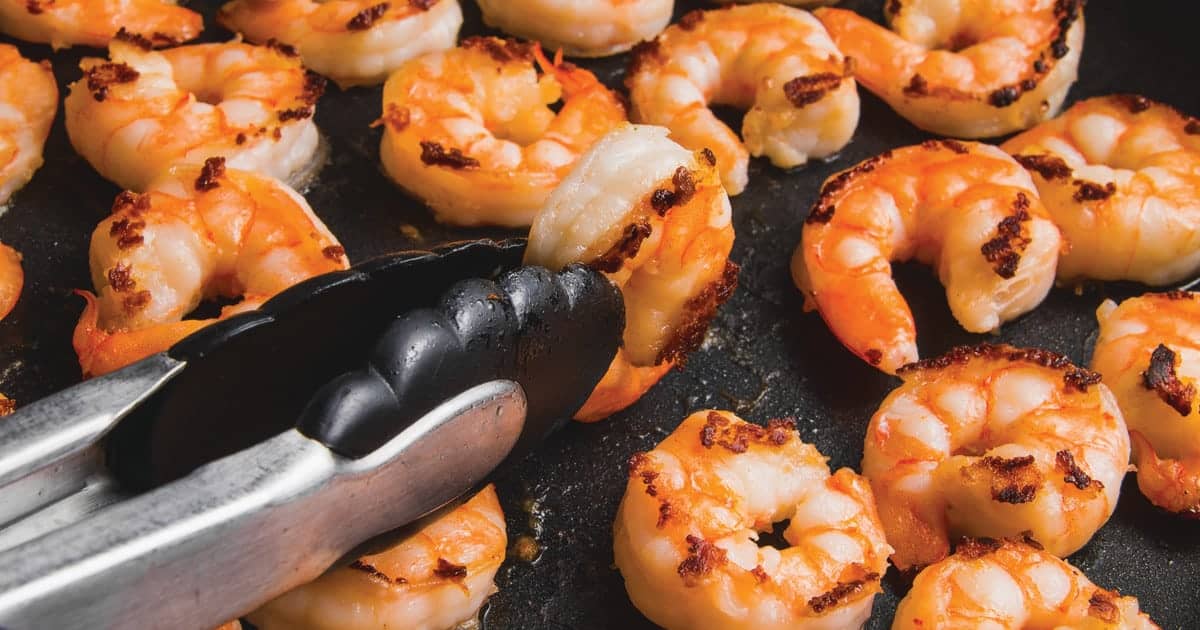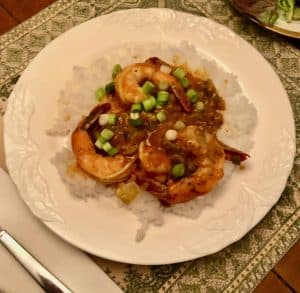Shrimp has many virtues. Among them is the lightning speed in which they cook.
That is also their bugaboo. Overcooked shrimp are dried out and rubbery. In a recent Cook’s Illustrated, Andrew Janjigian pointed out the problem. Shrimp are best cooked at just 120 degrees F. But most home cooks, wanting the deep flavor of shrimp browned on the outside and succulent on the inside, fire up their oil-coated pans. This is, Andrew insists, the wrong thing to do. Instead, he recommends a technique familiar to the one that forever changed the way we cook steak (See: http://chewingthefat.us.com/2020/04/forget-everything-you-know-about-cooking-a-great-steak.html ).

Here are Andrew Janjigian’s 5 Steps to perfect Pan-seared Shrimp
First, briefly salt the shrimp for 15 and up to 30 minutes. This helps shrimp retain moisture as they are seared. And the salt also seasons the shrimp.
Second, sprinkle sugar on the shrimp after you’ve patted them dry from their salting. This boosts browning and underlines their natural sweetness.
Third, always use a non-stick pan and oil the shrimp and not the pan. Do not soak the shrimp in oil. 1 tablespoon is all it takes per 1.5 lbs of shrimp.
Fourth, start cold, sear gently. The steak lesson learned was that this allows the protein to cook more evenly. With shrimp, this means they won’t buckle, will brown more evenly, and are less likely to overcook.
Fifth, flip and finish off heat. Once the first side of the shrimp is brown on the sides and pink on the edges, cut the heat completely and quickly turn each shrimp. The residual heat in the pan will cook the shrimp the rest of the way.
All that being said, that’s not exactly how I cooked today’s Shrimp Étouffee
In this take on Etouffée, I made the wonderful celery-onion-bell pepper tomatoey sauce. I then laid the salted, sugared shrimp on top of the sauce, cooked them on one side, and then turned them over to finish them. In essence, the sauce kept the shrimp away from direct heat so we accomplished our goal of perfectly cooked shrimp. This recipe is from Vallery Lomas. Vallery describes herself as a ‘recovering attorney’. After winning Season 3 of ABC-TV’s Great American Baking Show, she turned to food full time. Her first cookbook, for Clarkson Potter, will be published in September 2021. This recipe first appeared in the New York Times.
How this recipe differs from a traditional ‘Étouffée
In both Creole and Cajun kitchens, étouffée is generally made using crawfish tails. Since the crawfish season is short and very few crawfish ever leave Louisiana, Vallery used this noble substitute, Shrimp, in this recipe for 4. An ‘Étoufée, translated from its original French, simply means “smothered”. Here the shrimp is ‘smothered’ in the glorious sauce. Vallery Lomas used a shortcut version of a traditional roux. Instead of making the roux separately, the flour is added to the vegetables that have been sautéed in butter. Then for a warm spicy flavor, both Creole seasoning and a splash of hot sauce are put to work. I finally found Creole seasoning the third market I shopped for it in. Ms. Lomax included the recipe for making your own which I’ve included in the recipe which follows. And after the recipe, some other shrimp dishes you might enjoy.
Shrimp Étoufée
A full-of-flavor Shrimp dish that brings both Cajun and Creole traditions together in just minutes.

Ingredients
- 4 tablespoons unsalted butter
- 1 yellow onion, finely chopped
- 2 celery stalks, thinly sliced
- ½ green bell pepper, finely chopped
- 4 garlic cloves, minced
- 3 tablespoons all-purpose flour
- 2 tablespoons tomato paste
- ¾ cup chicken or vegetable stock
- 1 tablespoon hot sauce, or to taste
- 1 dried bay leaf
- 2 teaspoons store-bought or homemade Creole seasoning (see Tip)
- Kosher salt and black pepper
- 1 pound shrimp, peeled and deveined
- 1 scallion, green parts chopped
- White rice, for serving
Directions
- Step 1 To Make the Shrimp Étouffée:
- Step 2 In a large skillet, melt the butter over medium-high heat. Add the onion, celery, and bell pepper, and cook until softened, about 7 minutes. Add the garlic and cook until fragrant, 1 more minute.
- Step 3 Sprinkle the flour over the ingredients and stir constantly until lightly toasted, about 5 minutes. Add the tomato paste, and stir and cook for 1 more minute.
- Step 4 Pour in the stock and 3/4 cup water. Cook until the liquid is reduced by half, about 3 minutes. Add the hot sauce, bay leaf, Creole seasoning, 1 teaspoon salt, and 1/2 teaspoon pepper. Bring to a boil, and cook until the mixture starts to thicken about 2 minutes.
- Step 5 Stir in the shrimp and reduce the heat to medium. Simmer until the shrimp are cooked through and opaque, about 5 minutes, turning each piece halfway through. Remove from the heat. Taste and adjust seasoning. Sprinkle the scallions on top. Serve warm over rice.
- Step 6 To make your own Creole seasoning:
- Step 7 Combine 1 tablespoon smoked paprika, 1 tablespoon chile powder, 1 teaspoon onion powder, 1 teaspoon garlic powder, 1/2 teaspoon cayenne pepper (or less, if desired), 1/2 teaspoon fine sea salt, and 1/2 teaspoon black pepper in a small bowl and stir together. Store in an airtight container in a cool, dry place.














